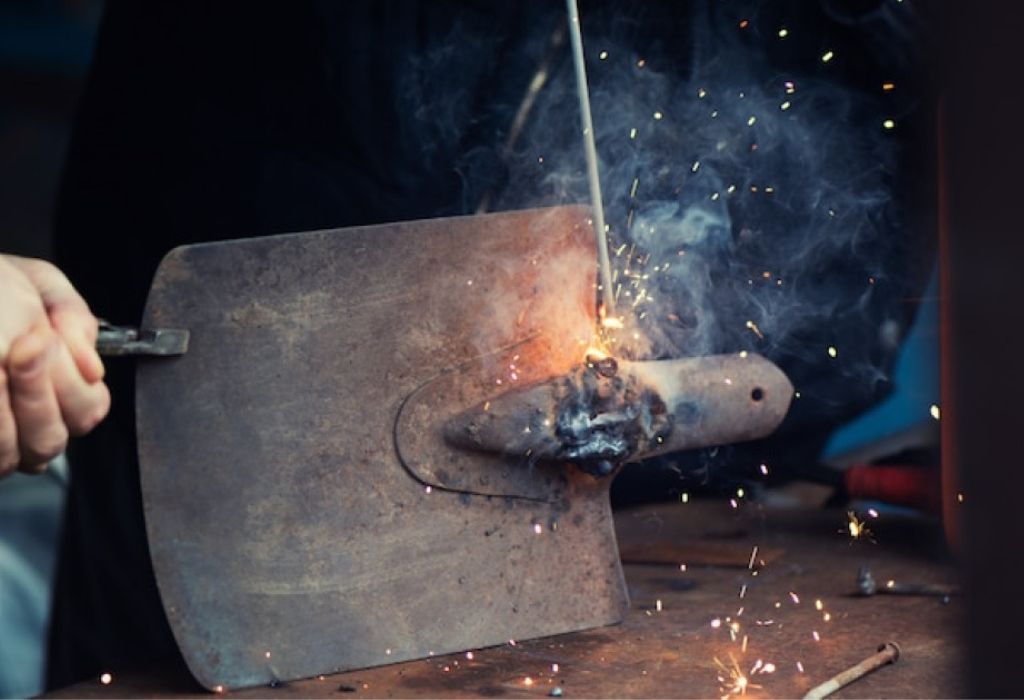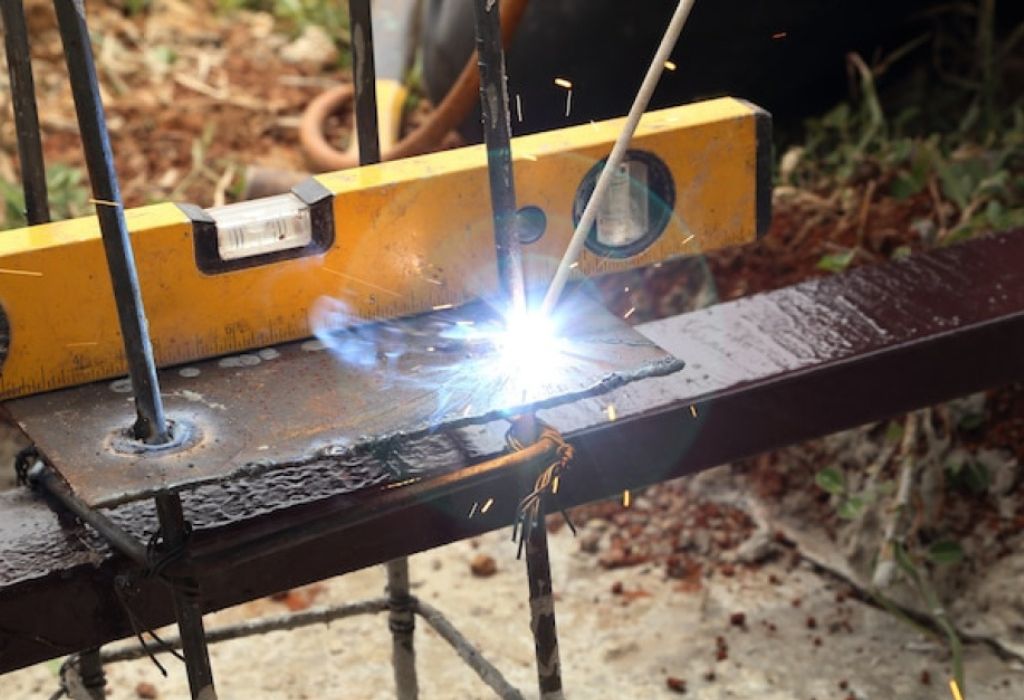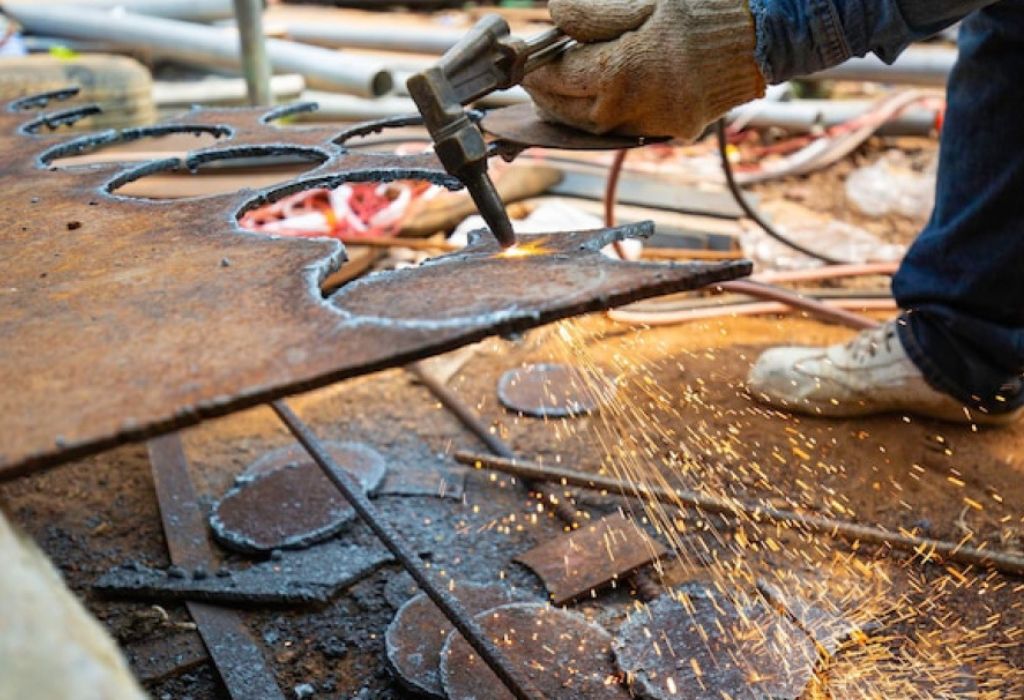A cracked cast iron exhaust manifold ruins a weekend project and the repair shop is far away.
The question appears immediately in the garage: can you weld cast iron and make it last.
Cast iron is strong in compression but brittle when stressed or shocked by heat.
Its high carbon content and graphite structure make the heat-affected zone prone to cracking as it cools.
Preheating slows the cooling rate and reduces hard martensite in the HAZ.
That is why reputable guidance stresses even preheat and slow cool for reliable repairs. Twi Global+1
Typical preheat guidance for cast iron spans 100–400 °C depending on section and procedure.
Many repair procedures for heavier parts cite 500–1200 °F while warning not to exceed critical temperatures. Twi Global+1
This guide explains when welding works, which process to choose, and how to control heat.
Every section includes concise Q&A to answer search-style queries clearly for readers and answer engines.
Why Cast Iron Is Hard To Weld

Cast iron contains more carbon than most steels and much of that carbon exists as graphite.
Graphite flakes or nodules act like tiny stress concentrators that raise crack risk during heating and cooling. Twi Global
Rapid cooling after a weld can form hard and brittle microstructures in the HAZ.
These structures make the joint vulnerable to immediate or delayed cracking unless heat is controlled. Twi Global
Q&A
Why does cast iron crack after welding
Thermal contraction and hard HAZ microstructures combine to create brittle zones that split as the part cools. Twi Global
Which cast irons are most weldable
Grey iron is commonly repaired, while ductile and malleable irons require tighter control of heat and filler choice. Twi Global
Is slow cooling really necessary
Yes, slow cooling lowers hardness and stress in the HAZ and reduces the chance of cracks forming. Twi Global
Can You Weld Cast Iron
Yes, cast iron can be welded when the procedure, filler, and heat control match the job.
Choose between fusion welding methods or braze welding based on service demands and risk tolerance.
Common Methods At A Glance
SMAW with nickel electrodes is the most used repair method for general cast iron work.
Nickel 99 deposits are very machinable and Nickel 55 offers higher strength for mixed joints and ductile iron. lincolnelectric.com
GTAW or GMAW with nickel wire can produce precise beads on small repairs.
Heat must be kept low with short beads and pauses to avoid HAZ damage.
Braze welding with bronze filler joins at lower temperatures without melting the base iron.
It is ideal for leak sealing, dissimilar metal joints, and parts where distortion must be minimal. Lucas Milhaupt+1
Q&A
What is the safest all-round filler for cast iron repairs
Nickel-based consumables are widely recommended because they accommodate carbon and remain machinable. lincolnelectric.com
When should brazing be preferred over welding
Choose brazing for thin, intricate, or antique castings where lower heat and reduced distortion are priorities. Lucas Milhaupt
Are steel electrodes a good idea
Steel electrodes can create very hard deposits and HAZ regions that are difficult to machine and more crack-prone. Twi Global
Can small cracks be repaired without full preheat
Cold techniques with very short beads and long cool pauses exist, but heat control becomes more critical than ever. lincolnelectric.com
Preheat, Interpass, And Cooling

Preheating the joint area or the entire casting evens temperature gradients.
This slows cooling, reduces hydrogen issues, and helps prevent martensite formation in the HAZ. Miller Welds
Authoritative ranges for cast iron preheat often fall between 100–400 °C for many repairs.
Heavier or highly restrained sections may call for 500–1200 °F while avoiding the critical range near 1400 °F. Twi Global+1
Control interpass temperature so the part does not exceed procedure limits.
Measure, pause, and allow temperature equalization between beads for consistency and crack resistance. NORTH AMERICA ENGLISH
Slow cooling is essential after welding to reduce stress.
Insulate the part with blankets or bury in dry media to extend the cool-down period. lincolnelectric.com
Q&A
What preheat number should be used to start
Aim for a conservative value within the 100–400 °C band, then adjust for section thickness and procedure notes. Twi Global
Why limit interpass temperature
Excessive heat increases distortion and hardness while reducing toughness in the HAZ. NORTH AMERICA ENGLISH
How should the part be cooled after welding
Let it cool slowly under insulation to minimize thermal shock and residual stress. lincolnelectric.com
Is local preheat enough
Whole-casting heat is ideal when practical, yet localized preheat with careful monitoring works on many repairs. Twi Global
Joint Preparation And Fit-Up
Remove oil, paint, rust, and graphite-rich skin from the repair area.
Grind a V-groove to sound metal and stop-drill crack tips to prevent further propagation during heating.
Maintain good access and a consistent root for filler metal placement.
Align and clamp to keep stresses as low as possible during heating and cooling.
Q&A
Why is stop-drilling recommended
Stop-holes relieve stress at crack tips and help prevent the crack from growing under heat.
Do casting skins need removal
Yes, the outer skin often holds impurities that contaminate weld metal and create porosity.
Should edges be sharp or blended
Blend the groove to remove sharp corners that concentrate stresses during expansion and contraction.
Filler Metal Selection
Nickel 99 electrodes give a soft, machinable deposit and are common for general grey iron repairs.
Nickel 55 offers higher strength and is helpful when welding cast iron to steel or on ductile iron. lincolnelectric.com
Follow the consumable data sheet for polarity, bead length, and peening guidance.
Many nickel rods advise short stringer beads, skip welding, and controlled slow cooling after the last pass. ch-delivery.lincolnelectric.com
Bronze filler for braze welding is selected for joint gap and service needs.
It allows joining without melting the base metal and excels for sealing and dissimilar metal joints. Lucas Milhaupt+1
Q&A
Which filler is most machinable
Nickel 99 deposits are designed for easy machining on typical repairs. lincolnelectric.com
Which filler is stronger for mixed joints
Nickel 55 is commonly used when joining cast iron to steel because of its iron content and strength balance. lincolnelectric.com
When choose bronze instead of nickel
Use bronze when lower heat, seal integrity, or joining dissimilar metals outweighs the need for fusion-weld strength. Lucas Milhaupt
Step-By-Step Repair Workflow
- Identify the likely iron type and decide on welding or brazing based on service loads.
- Degrease, stop-drill ends, and grind a V-groove to clean metal.
- Preheat the joint area or the entire casting to the selected temperature.
- Weld very short beads and peen lightly to counter contraction.
- Respect interpass limits, then insulate for slow cooling. Twi Global+1
Q&A
Why peen between beads
Peening introduces compressive stress that offsets tensile contraction as the bead cools. ch-delivery.lincolnelectric.com
How long should beads be
Keep them short to limit heat input and allow time for temperature equalization. ch-delivery.lincolnelectric.com
What if distortion appears
Reduce heat input, improve fixturing, and increase time between passes to stabilize the part.
Common Problems And Prevention
Porosity results from contamination or gas trapped in the casting.
Improve cleaning, maintain correct temperature, and avoid drawing oil into the weld area.
Cracking in the HAZ arises from steep thermal gradients and hard microstructures.
Use proper preheat, short beads, and slow cooling to reduce risk. Twi Global
Unmachinable hard spots occur with steel-rich deposits and fast cooling.
Select nickel fillers and manage cooling to keep the deposit and HAZ workable. lincolnelectric.com
Q&A
Why did the joint crack the next day
Delayed cracking happens as residual stresses build while the casting cools and hardens in the HAZ. Twi Global
Why are there pinholes along the bead
Trapped gases and surface contamination are common causes that better prep and temperature control can fix.
Can hard deposits be softened later
Post-heat and controlled slow cool can reduce hardness in some cases, though recutting may still be required.
When To Choose Brazing Instead Of Welding
Brazing joins at a lower temperature so the base iron does not melt.
This reduces distortion and the risk of HAZ cracking, which is valuable for thin or intricate castings. Lucas Milhaupt
Capillary action draws molten bronze into a properly designed joint.
The process is effective for leak sealing, dissimilar metals, and repairs where color match is secondary to soundness. Lucas Milhaupt
Q&A
Is a brazed joint strong enough
Properly made brazed joints can be very strong and are often more than adequate for non-structural repairs. Lucas Milhaupt
Will the color match the casting
Color may differ from the base metal and is a tradeoff for the lower temperature process.
Can brazing be machined
Yes, most bronze fillers machine well although tool selection and feed rates should be adjusted.
Safety, Heat Control, And Distortion

Use accurate temperature measurement to manage preheat and interpass.
Temperature crayons and infrared thermometers help keep the procedure inside safe limits. NORTH AMERICA ENGLISH
Shield nearby gaskets and machined faces from heat.
Support heavy parts so movement does not introduce new stresses during welding or cooling.
Q&A
Can uneven preheat cause failure
Yes, uneven heating creates local expansion that drives cracks as the part cools.
What is the best way to slow cool
Wrap in welding blankets or bury in dry insulating media to avoid sudden temperature drops. lincolnelectric.com
Is post-weld heat treatment required
Not always, yet controlled slow cooling serves the same purpose on many cast iron repairs.
Final Checklist
Identify the casting type and the service loads before choosing a process.
Prep thoroughly, select nickel or bronze filler as appropriate, and plan the heat path.
Preheat within the recommended range and measure interpass to avoid exceeding procedure targets.
Weld short beads, peen lightly, and allow equalization between passes for stability. lincolnelectric.com+1
Insulate for slow cooling to reduce residual stress and hardness.
Inspect the repair once cool and machine as needed for final fit.
Q&A
One rule that prevents many failures
Control heat from start to finish with measured preheat, short beads, and slow cooling. Twi Global
Best filler for a machined finish
Nickel 99 is commonly selected for machinable deposits on grey iron. lincolnelectric.com
Best option when distortion is unacceptable
Braze welding with bronze filler keeps temperatures lower and limits distortion. Lucas Milhaupt
Conclusion
The short answer to can you weld cast iron is yes with the right plan.
Success hinges on filler choice, thorough prep, and a disciplined approach to preheat, interpass, and slow cooling.
Nickel electrodes and careful technique deliver strong, machinable repairs on many grey iron parts.
Brazing remains a powerful alternative when lower heat and reduced distortion matter more than fusion strength. Lucas Milhaupt
Use the checklist in this guide before striking an arc and verify temperatures rather than guessing.
The result is a sound repair that resists cracking and performs reliably in service.
ChatGPT can make mistakes. Check important info.

I’m Darrell Julian, the founder, lead writer, and hands-on welding enthusiast behind ArcWeldingPro.com. With more than 15 years of real-world welding experience, I created this platform to share what I’ve learned in the field, in the shop, and in the heat of the arc.


